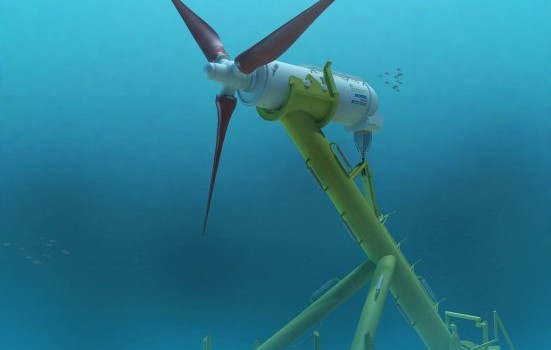
Sound of Islay Tidal Project Background
In March 2011, the Scottish Government gave consent for a test tidal turbine to be installed in the Sound of Islay by Scottish Power Renewables, which is a tidal stretch of water between the Isle of Islay and the Isle of Jura.
The HS1000 tidal turbine looks very similar to traditional onshore wind turbines that are now commonplace across the UK. This turbine was designed by Hammerfest Strom AS, who have been successfully running a smaller 300kw turbine in Norway for the last 6 years. The HS1000 is significantly bigger with a capacity of 1MW, which should generate approximately 3GWh of electricity per year, enough to power about 600 houses.
These turbines will stand approximately 33m tall from the seabed to the tip of the turbine blade, which will still leave clearance of about 17m to the surface of the water, so there should be no impact of boats travelling up and down the Sound of Islay.
In December 2011, Hammerfest engineers installed the first of the HS1000 tidal turbines, which has successfully been running ever since. The plan is now to install an additional nine turbines bringing the total capacity up to the 10MW, with the array being completed in 2013.
Comparison to Existing Tidal Energy Projects
Unlike the Rance Tidal Barrage which takes advantage of the potential energy at high and low tide, these new types of turbines take advantage of the kinetic energy of the moving tidal water. This difference is key, as the HS1000 turbine arrays can be built up in a modular fashion, adding additional turbines, one at a time to increase the capacity of the entire turbine array. There are also none of the associated environmental impacts with damming an estuary, which means the installations are cheaper and capacity can be added as funds become available.
The benefit of positioning the turbines in the water comes down to the density of water; it is approximately 800 times more dense than air, so for the same rotor swept area, water moving at 2.5m/s has the same amount of force as wind blowing at 350km/h!
Unlike wind turbines that rotate to face the wind, these tidal turbines will not rotate, instead the individual blades will turn to face the flow. This is because in tidal waters, the direction of flow is only bidirectional, so there is no need for the full rotational functionality.
Electrical Output of the Sound of Islay Tidal Project
The electricity produced by the turbines when all 10 come online in 2013, will be something close to 30GWh, which will be enough to power approximately 6000 houses. The combined energy consumption of both the Isle of Islay & Isle of Jura is also approximately 30GWh, however as tidal energy is not always producing power (in between tides), the islands will still have to import electricity at these times (lack of energy storage). However, during the full tidal flow the electricity produced will comfortably be able to cover the requirements of both islands and the excess will be exported.
Environmental Impact Of The Sound Of Islay Tidal Project
Prior to planning permission being granted for the Sound of Islay Tidal Project, an environmental impact assessment was carried out to assess the potential impact of sea-life in the area. It was concluded there would be very little impact on the local ecosystem as the blades spin relatively slowly (10 times per minute), and in their smaller test turbine project (300kw turbine), no impact was seen.












No Comments yet! Be the first one.